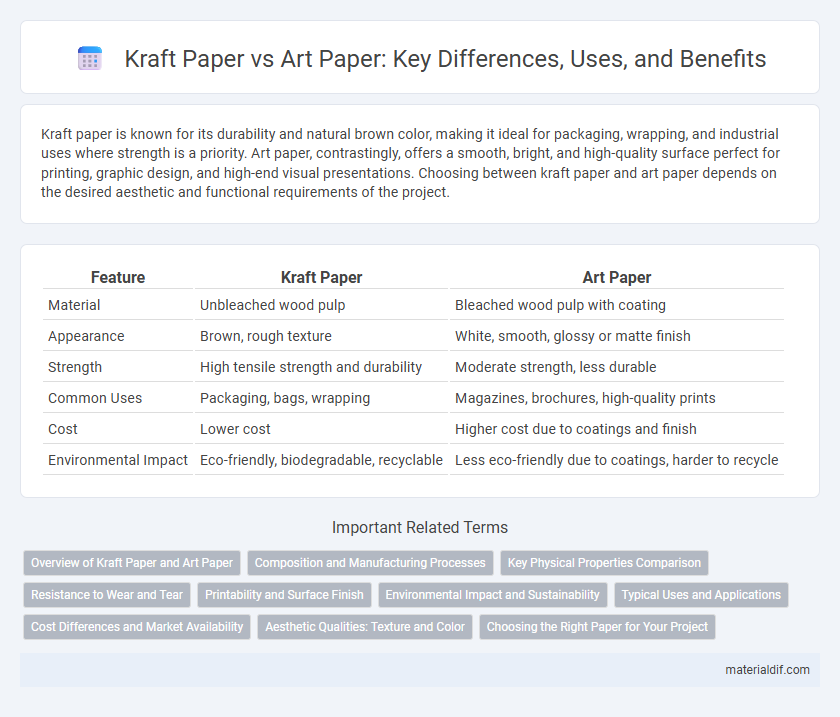Kraft paper is known for its durability and natural brown color, making it ideal for packaging, wrapping, and industrial uses where strength is a priority. Art paper, contrastingly, offers a smooth, bright, and high-quality surface perfect for printing, graphic design, and high-end visual presentations. Choosing between kraft paper and art paper depends on the desired aesthetic and functional requirements of the project.
Table of Comparison
| Feature | Kraft Paper | Art Paper |
|---|---|---|
| Material | Unbleached wood pulp | Bleached wood pulp with coating |
| Appearance | Brown, rough texture | White, smooth, glossy or matte finish |
| Strength | High tensile strength and durability | Moderate strength, less durable |
| Common Uses | Packaging, bags, wrapping | Magazines, brochures, high-quality prints |
| Cost | Lower cost | Higher cost due to coatings and finish |
| Environmental Impact | Eco-friendly, biodegradable, recyclable | Less eco-friendly due to coatings, harder to recycle |
Overview of Kraft Paper and Art Paper
Kraft paper is a durable, coarse-textured paper made from chemical pulp, known for its high tear resistance and natural brown color, commonly used in packaging and industrial applications. Art paper features a smooth, coated surface designed for high-quality printing and vibrant color reproduction, ideal for brochures, magazines, and art books. Both types differ significantly in texture, strength, and intended use, with kraft paper emphasizing durability and eco-friendliness while art paper prioritizes aesthetic appeal and print clarity.
Composition and Manufacturing Processes
Kraft paper is produced using the kraft process, which involves chemically treating wood pulp with sodium hydroxide and sodium sulfide to remove lignin and impurities, resulting in a strong, coarse-textured paper mainly composed of cellulose fibers. Art paper, by contrast, is created through mechanical or chemical pulping methods, often enhanced with clay or calcium carbonate coatings to achieve a smooth, bright, and glossy surface ideal for high-quality printing. The manufacturing of kraft paper emphasizes durability and tensile strength, while art paper focuses on optical properties and surface finish for aesthetic purposes.
Key Physical Properties Comparison
Kraft paper exhibits high tensile strength and durability due to its long wood fibers, making it ideal for packaging and industrial uses. Art paper features a smooth, coated surface with excellent brightness and opacity, optimized for high-quality printing and image reproduction. While kraft paper prioritizes robustness and resistance to tearing, art paper emphasizes visual appeal and ink absorption for detailed artwork.
Resistance to Wear and Tear
Kraft paper exhibits superior resistance to wear and tear due to its high fiber strength and durability, making it ideal for packaging and industrial use. Art paper, while smoother and brighter for printing, generally possesses thinner fibers that are more prone to damage under stress or abrasion. The robust composition of kraft paper ensures enhanced longevity in rough handling situations compared to the delicate surface of art paper.
Printability and Surface Finish
Kraft paper offers excellent printability for rustic and eco-friendly designs due to its porous surface, which absorbs ink well but may result in slightly muted colors. Art paper provides a smooth, coated surface that enhances sharp image reproduction and vibrant color output, making it ideal for high-quality prints. The choice between kraft and art paper depends on the desired aesthetic and print detail, balancing texture against clarity.
Environmental Impact and Sustainability
Kraft paper, made from wood pulp with minimal processing, offers higher recyclability and biodegradability compared to art paper, which often contains chemical coatings and additives that hinder decomposition. The production of kraft paper utilizes fewer chemicals and less energy, reducing its carbon footprint and promoting sustainability. Choosing kraft paper supports environmentally friendly packaging and printing solutions by minimizing waste and conserving natural resources.
Typical Uses and Applications
Kraft paper is primarily used for packaging, wrapping, and industrial applications due to its high strength and durability, making it ideal for shipping, grocery bags, and protective packaging. Art paper is favored in printing, graphic design, and fine art projects because of its smooth surface and superior print quality, which enhances detail and color vibrancy in brochures, posters, and high-end invitations. Both types serve distinct purposes, with kraft paper excelling in utility and art paper preferred for aesthetic presentations.
Cost Differences and Market Availability
Kraft paper is significantly more cost-effective than art paper due to its simpler manufacturing process and lower material costs, making it a preferred choice for packaging and industrial use. Art paper, often coated and possessing a smoother finish, commands a higher price because of enhanced printing quality and its application in premium marketing materials and high-end publications. Market availability shows kraft paper is widely accessible globally, whereas art paper is more specialized, with varied availability depending on regional printing demands.
Aesthetic Qualities: Texture and Color
Kraft paper features a coarse texture and natural brown hue that imparts a rustic, organic aesthetic favored for eco-friendly packaging and artisanal crafts. Art paper offers a smooth, refined surface with a bright white or colored finish, enhancing print clarity and vibrant color reproduction for high-quality visual presentations. The choice between kraft and art paper significantly impacts the tactile experience and visual appeal in design and packaging applications.
Choosing the Right Paper for Your Project
Kraft paper offers durability and a rustic, natural look ideal for eco-friendly packaging and craft projects, while art paper provides a smooth, high-quality finish perfect for detailed printing and vibrant color reproduction. Selecting the right paper depends on the project's purpose, desired texture, and printing technique, with kraft paper excelling in strength and recyclability and art paper enhancing visual appeal. Understanding these characteristics ensures optimal presentation and functionality for your specific creative needs.
Kraft Paper vs Art Paper Infographic

 materialdif.com
materialdif.com